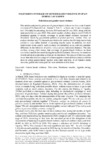Mostrar el registro sencillo del ítem
Television coverage of gender-based violence in Spain during lockdown
| dc.contributor.author | Nozal, Teresa | |
| dc.contributor.author | Sanjuán Pérez, Antonio | |
| dc.contributor.author | Martínez Costa, Sandra | |
| dc.contributor.author | Videla-Rodríguez, José-Juan | |
| dc.date.accessioned | 2024-02-08T20:10:33Z | |
| dc.date.available | 2024-02-08T20:10:33Z | |
| dc.date.issued | 2022 | |
| dc.identifier.citation | Nozal Cantarero, T., Sanjuán Pérez, A., Martínez Costa, S., & Videla Rodríguez, J. J. (2022). Television coverage of gender-based violence in Spain during lockdown. Violence and Gender, 9(3), 105-114. | es_ES |
| dc.identifier.issn | 2326-7836 | |
| dc.identifier.issn | 2326-7852 | |
| dc.identifier.uri | http://hdl.handle.net/2183/35546 | |
| dc.description | This is the accepted version of the following article: [Nozal Cantarero, T., Sanjuán Pérez, A., Martínez Costa, S., & Videla Rodríguez, J. J. (2022). Television coverage of gender-based violence in Spain during lockdown. Violence and Gender, 9(3), 105-114], which has now been formally published in final form at [Violence and Gender] at [https://doi.org/10.1089/vio.2021.0081]. This original submission version of the article may be used for non-commercial purposes in accordance with the Mary Ann Liebert, Inc., publishers’ self-archiving terms and conditions. | es_ES |
| dc.description.abstract | [Abstract]: This article analyzes the presence of gender-based violence on free-to-air Spanish television (TV) channels La1, Antena 3, Tele 5, La Sexta, and Cuatro throughout their 24-h daily broadcasting, between 20 March and 20 June 2020, along with the same period for the year 2019. This article studies whether, despite the COVID-19 dominated agenda of media, coverage of gender-based violence increased or decreased, driven by government policies to protect potential victims. Also, we analyze whether any TV channels provided tools (such as the 016 helpline) to help women or were rather limited to reporting murder cases. In addition, the most predominant terms used in such coverage are identified, along with any potential difference in the behavior of public versus private television channels. The data confirm, among other issues, that coverage of gender-based violence on these television channels decreased during the studied timeframe. However, the mentions of tools aimed at supporting women at risk increased. The results of this study also reveal that television coverage of violence against women did not coincide with the dates in which gender-based murders took place and that, of all Spanish media networks, public television paid the most attention to this issue. | es_ES |
| dc.language.iso | eng | es_ES |
| dc.publisher | Mary Ann Liebert, Inc. | es_ES |
| dc.relation.uri | https://doi.org/10.1089/vio.2021.0081 | es_ES |
| dc.rights | Atribución-NoComercial-SinDerivadas 3.0 España | es_ES |
| dc.rights.uri | http://creativecommons.org/licenses/by-nc-nd/3.0/es/ | * |
| dc.subject | Gender-based violence | es_ES |
| dc.subject | Television | es_ES |
| dc.subject | Machismo murder | es_ES |
| dc.subject | Agenda setting | es_ES |
| dc.subject | Framing | es_ES |
| dc.title | Television coverage of gender-based violence in Spain during lockdown | es_ES |
| dc.type | journal article | es_ES |
| dc.rights.accessRights | open access | es_ES |
| UDC.journalTitle | Violence and Gender | es_ES |
| UDC.volume | 9 | es_ES |
| UDC.issue | 3 | es_ES |
| UDC.startPage | 105 | es_ES |
| UDC.endPage | 114 | es_ES |
| UDC.coleccion | Investigación | es_ES |
| UDC.departamento | Dereito Público | es_ES |
| UDC.grupoInv | Cultura e Comunicación Interactiva | es_ES |
Ficheros en el ítem
Este ítem aparece en la(s) siguiente(s) colección(ones)
-
Investigación (FCOM) [208]






